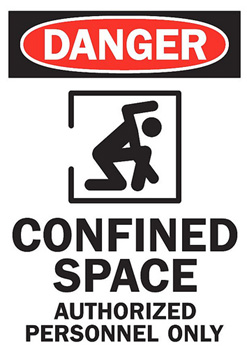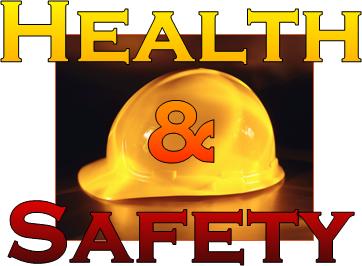 Many workplaces contain spaces that are considered “confined” because their configurations hinder the activities of employees who must enter, work in, and exit them. A confined space has limited or restricted means for entry or exit, and it is not designed for continuous employee occupancy. Confined spaces include, but are not limited to underground vaults, tanks, storage bins, manholes, pits, silos, process vessels, and pipelines. OSHA uses the term “permit-required confined space” (permit space) to describe a confined space that has one or more of the following characteristics: contains or has the potential to contain a hazardous atmosphere; contains a material that has the potential to engulf an entrant; has walls that converge inward or floors that slope downward and taper into a smaller area which could trap or asphyxiate an entrant; or contains any other recognized safety or health hazard, such as unguarded machinery, exposed live wires, or heat stress.
Many workplaces contain spaces that are considered “confined” because their configurations hinder the activities of employees who must enter, work in, and exit them. A confined space has limited or restricted means for entry or exit, and it is not designed for continuous employee occupancy. Confined spaces include, but are not limited to underground vaults, tanks, storage bins, manholes, pits, silos, process vessels, and pipelines. OSHA uses the term “permit-required confined space” (permit space) to describe a confined space that has one or more of the following characteristics: contains or has the potential to contain a hazardous atmosphere; contains a material that has the potential to engulf an entrant; has walls that converge inward or floors that slope downward and taper into a smaller area which could trap or asphyxiate an entrant; or contains any other recognized safety or health hazard, such as unguarded machinery, exposed live wires, or heat stress.
Tag: human resources
The Distracted Driving Epidemic
 Distracted driving has become an epidemic in the United States, and its often fatal consequences are a threat to your workers, your business and the public.
Distracted driving has become an epidemic in the United States, and its often fatal consequences are a threat to your workers, your business and the public.
Because millions of workers’ jobs require them to spend part or all of their work day driving ― visiting clients and customers, making site visits, or delivering goods and services ― the Departments of Labor (DOL) and Transportation (DOT) are joining forces in a campaign to stop distracted driving and save lives.
Year after year, the leading cause of worker fatalities is motor vehicle crashes. There’s no question that new communications technologies are helping business work smarter and faster. But getting work done faster does not justify the dramatically increased risk of injury and death that comes with texting while driving.
The human toll is tragic. DOT reports that in 2009, more than 5,400 people died in crashes linked to distraction and thousands more were injured. “Texting while driving” has become such a prominent hazard that 30 states now ban text messaging for all drivers.
via Distracted Driving.
Benefits of Employee Recognition in the Workplace
 When you have offices, departments and teams of loyal, committed, trained and qualified staff, you are reducing your risk. Give everyone an annual raise, make sure the air conditioning runs in the summer and the heat in the winter and voila… resignations will stop and retention is achieved. Right?
When you have offices, departments and teams of loyal, committed, trained and qualified staff, you are reducing your risk. Give everyone an annual raise, make sure the air conditioning runs in the summer and the heat in the winter and voila… resignations will stop and retention is achieved. Right?
Wrong! Having an efficiently run work environment with comfortable temperatures and scheduled pay raises won’t be enough to retain your staff. It will be enough to get them to show up every morning — but to take initiative, meet schedules and deadlines, operate with a seriousness of purpose and drive — that requires relationship-building and employee recognition programs that work.
Business Case for Safety and Health
 Employers that invest in workplace safety and health can expect to reduce fatalities, injuries, and illnesses. This will result in cost savings in a variety of areas, such as lowering workers’ compensation costs and medical expenses, avoiding OSHA penalties, and reducing costs to train replacement employees and conduct accident investigations. In addition, employers often find that changes made to improve workplace safety and health can result in significant improvements to their organization’s productivity and financial performance.
Employers that invest in workplace safety and health can expect to reduce fatalities, injuries, and illnesses. This will result in cost savings in a variety of areas, such as lowering workers’ compensation costs and medical expenses, avoiding OSHA penalties, and reducing costs to train replacement employees and conduct accident investigations. In addition, employers often find that changes made to improve workplace safety and health can result in significant improvements to their organization’s productivity and financial performance.
Conflict Resolution
 Are people fighting more these days, or does it just seem that way? Whatever the case, learning to resolve conflicts can help young people break down barriers, become leaders, and even prevent deadly confrontations.
Are people fighting more these days, or does it just seem that way? Whatever the case, learning to resolve conflicts can help young people break down barriers, become leaders, and even prevent deadly confrontations.
Conflict can be negative – in its ultimate form it can lead to war – but it can also be positive, depending on how it’s resolved. For example, it can help get feelings out in the open, help people learn from disagreements, resolve problems, gain someone more respect, or enable people to learn that others are willing to stand up for themselves and what they believe in. In fact, conflict is a natural human process that doesn’t have to lead to violence; conflict resolution and anger management techniques can provide opportunities for people to grow and improve their relationships and the quality of life of those around them despite the inevitable disagreements that arise.
via Conflict Resolution — National Crime Prevention Council.
Safety and Health Add Value
 Addressing safety and health issues in the workplace saves the employer money and adds value to the business. Recent estimates place the business costs associated with occupational injuries at close to $170 billion – expenditures that come straight out of company profits.
Addressing safety and health issues in the workplace saves the employer money and adds value to the business. Recent estimates place the business costs associated with occupational injuries at close to $170 billion – expenditures that come straight out of company profits.
When workers stay whole and healthy, the direct cost-savings to businesses include:
- lower workers’ compensation insurance costs;
- reduced medical expenditures;
- smaller expenditures for return-to-work programs;
- fewer faulty products;
- lower costs for job accommodations for injured workers;
- less money spent for overtime benefits.
Safety and health also make big reductions in indirect costs, due to:
- increased productivity;
- higher quality products;
- increased morale;
- better labor/management relations;
- reduced turnover;
- better use of human resources.
Employees and their families benefit from safety and health because:
- their incomes are protected;
- their family lives are not hampered by injury;
- they have less stress.
Simply put, protecting people on the job is in everyone’s best interest – our economy, our communities, our fellow workers and our families. Safety and health add value to businesses, workplaces and lives.
Health Care Reform and Your Business
 The Patient Protection and Affordable Care Act of 2010, otherwise known as “Obamacare” or the “Health Care Law,” affects small and large businesses in several ways. How the health care law affects your business depends on the number of people you employ, either full time or part time (not counting independent contractors).
The Patient Protection and Affordable Care Act of 2010, otherwise known as “Obamacare” or the “Health Care Law,” affects small and large businesses in several ways. How the health care law affects your business depends on the number of people you employ, either full time or part time (not counting independent contractors).
Smaller Employers
Businesses that employ fewer than 25 full-time equivalent (FTE) employees may be eligible to receive a small business health care tax credit for providing health care coverage to employees. First, you must determine the number of full-time equivalent (FTE) employees, including each part-time employee as a percentage of a full-time employee. Then you must cover at least 50 percent of the cost of health care coverage for some of your employees, based on the single-person rate, and you must pay average annual wages below $50,000. If you meet all of these qualifications, you must apply on IRS Form 8941 (PDF) to receive the tax credit when you file your business tax return.
For Larger Employers
The health care law doesn’t “require” larger employers to provide health care to employees, but beginning in 2014 the law imposes penalties on businesses with over 50 employees that don’t provide “affordable” health care to employees. Here are the details of this portion of the law:
Starting in 2014, large businesses (those with 50 or more full-time workers) that do not provide adequate health insurance will be required to pay an assessment if their employees receive premium tax credits to buy their own insurance. These assessments will offset part of the cost of these tax credits. The assessment for a large employer that does not offer coverage will be $2,000 per full-time employee beyond the company’s first 30 workers.
To be deemed “affordable,” the health care insurance provided by the employer must pay for at least 60 percent of covered health care expenses, and employees may not be forced to pay more than 9.5 percent of their family income (before deductions and adjustments) for coverage offered by employers. The question of how an employer is supposed to know the amount of “family income” is not yet addressed.
If a business fails to provide any coverage or the coverage is deemed not to be affordable, the amount of the penalty is $2,000 per worker, but the first 30 workers are excluded from the calculation.
via Health Care Law and Your Business – Obamacare and Your Business.
Risk Management in Human Resources
 There are two types of roles in Risk Management. People are a source of risk. Shortage of right kind of employees at a right time, attrition of experienced employees, employee leaving after completion of a one-year training program, employees doing sloppy work due to lack of competencies, handling customers very badly, an employee unwilling to take on additional responsibility or high absentee employees.
There are two types of roles in Risk Management. People are a source of risk. Shortage of right kind of employees at a right time, attrition of experienced employees, employee leaving after completion of a one-year training program, employees doing sloppy work due to lack of competencies, handling customers very badly, an employee unwilling to take on additional responsibility or high absentee employees.
People are important in handling risk. People using their skill to solve unexpected problems, employees going the extra mile for the organization, an employee becoming multi-skilled, redesigning his own job to avoid unnecessary delays in getting work done, or evolving new process to resolve the problem or an employee persuading a talented friend to apply for a position and join the organization.
Bloodborne Pathogens and Needlestick Prevention
 What are bloodborne pathogens?
What are bloodborne pathogens?
Bloodborne pathogens are infectious microorganisms in human blood that can cause disease in humans. These pathogens include, but are not limited to, hepatitis B (HBV), hepatitis C (HCV) and human immunodeficiency virus (HIV). Needlesticks and other sharps-related injuries may expose workers to bloodborne pathogens. Workers in many occupations, including first aid team members, housekeeping personnel in some industries, nurses and other healthcare personnel may be at risk of exposure to bloodborne pathogens.
via Safety and Health Topics | Bloodborne Pathogens and Needlestick Prevention.
Human Capital Importance in an Organization
 Capital is defined as resource or the input into a business. Human capital can therefore be defined as an input in employees, the ability to perform a task with the aim of producing economic value. Human skills are needed to implement a business idea. Hence human capital importance is non-ignorable in a business. The ability to perform a task is gained by an individual through learning and experience.
Capital is defined as resource or the input into a business. Human capital can therefore be defined as an input in employees, the ability to perform a task with the aim of producing economic value. Human skills are needed to implement a business idea. Hence human capital importance is non-ignorable in a business. The ability to perform a task is gained by an individual through learning and experience.
